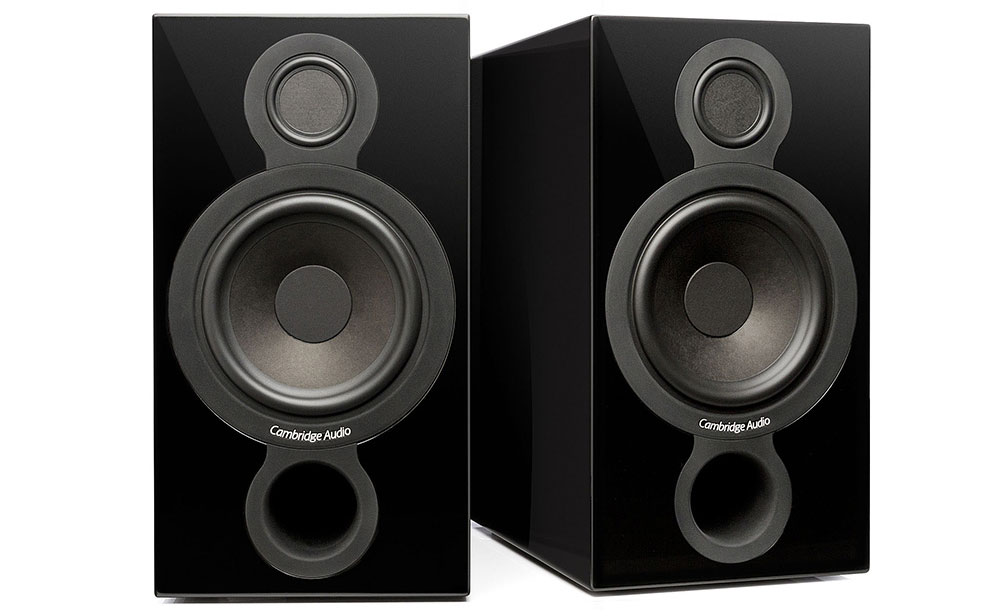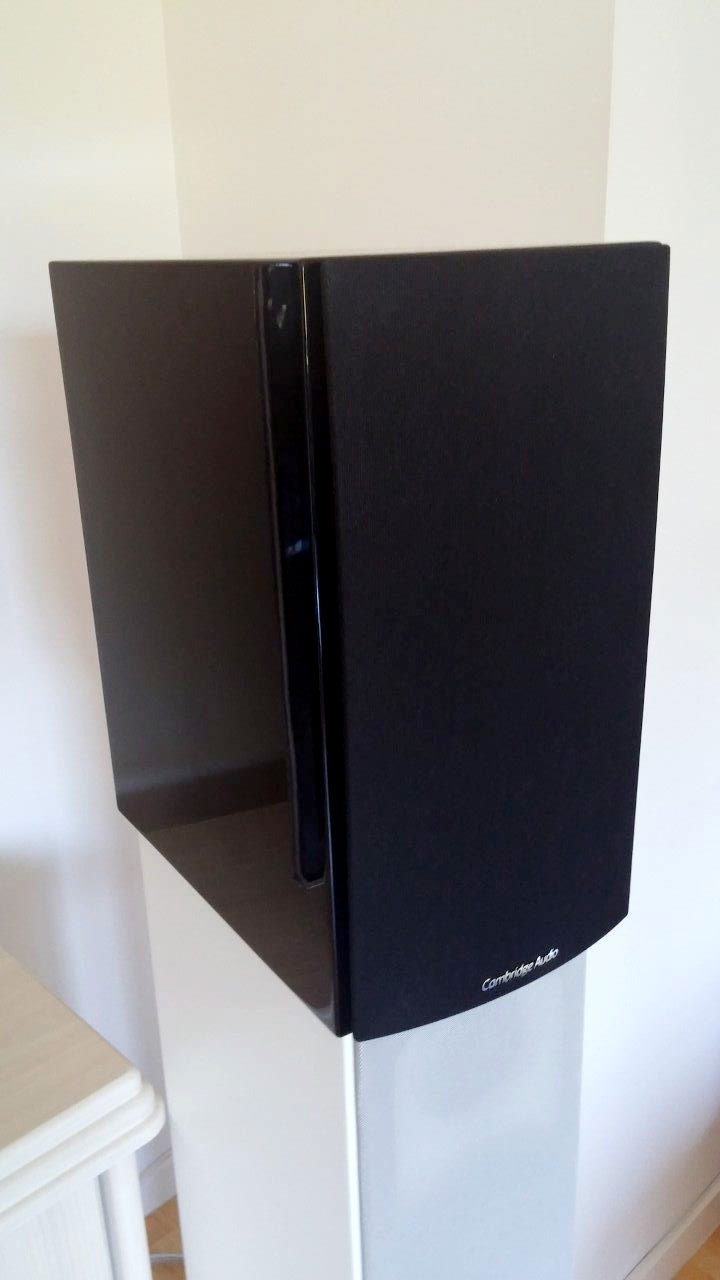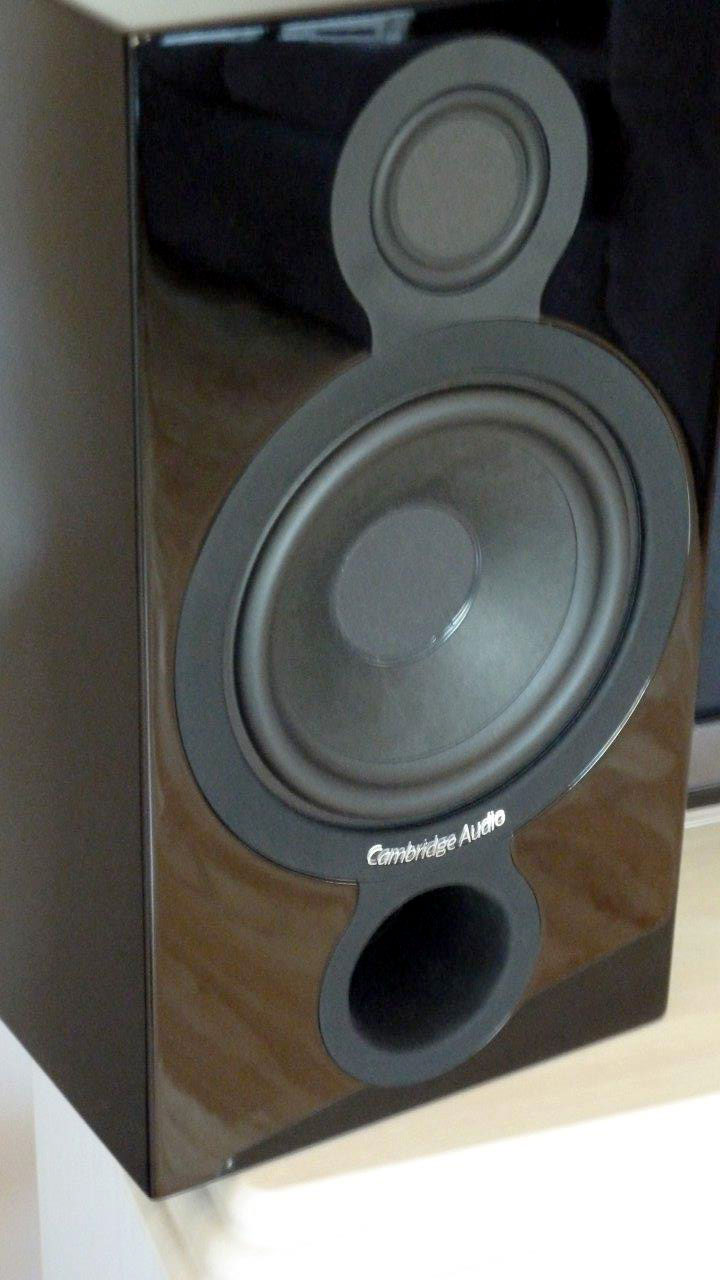Cambridge Audio Aeromax 2 Loudspeakers Review

For a company founded back in 1968, Cambridge Audio has continued its enviable reputation of being an innovative company. Initially known primarily for its range of amplifiers and tuners, they featured novel technical design and an attractive slim physical profile. The engineers at Cambridge Audio pride themselves on the thorough R&D needed to produce technically competent products but they are even prouder of the amount of listening they do, in order to ‘fine tune’ every new release and allow music to flow from relatively inexpensive equipment. Through the success of their budget hi-fi products they have managed to reinvent themselves and produce successful products that have moved them into the mid-tier market. The Aeromax 2 loudspeaker is no exception and is the subject of this review

The Aeromax 2 has been designed to be a stand mounted book shelf speaker, perhaps slightly larger than average in size, a front width of 203, height of 370 and a depth of 335mm. They weigh 7.24kg each and are finished in a stunning gloss black or white finish, looking very modern and with a small front profile. The grills, (in black only) are attached magnetically, appearing to simply sit on the front surface without any visible means, allowing easy removal for serious listening. Recommended amplifier power is from 25 to 120 Watts, with my listening tests suggesting that they can drive cleanly with the sensible use of even more than that. They are constructed to a very high standard with a flawless finish and an expensive look and feel.

BMR Driver
The Aeromax 2 are a ported two way design, utilising an unusual looking, totally flat 46mm (2”) Balanced Mode Radiator or BMR driver and a 165mm (6.5”) woofer. Cambridge Audio’s innovation is clearly seen in the use of this configuration. The BMR driver is used as a combination tweeter and midrange unit, covering frequencies from 22kHz down to 250Hz. The complimentary woofer then takes over the sole responsibility of the 250Hz to 40Hz range, allowing it to be designed to act in effect as a high range subwoofer rather than a mid/bass driver.
The advantages of this configuration are that each driver can be designed to operate in the frequency range it is most happy to be in and its low crossover point design lends itself to an uncoloured midrange. As Cambridge Audio state “Using the BMR shifts the crossover point between tweeter and woofer away from the usual 3kHz, right at the middle of the human ear's most sensitive hearing range, to a less problematic 250Hz. The result is a more natural, immersive and coherent sound.”
Also by replacing the traditional tweeter with a BMR driver, the Aeromax 2 offers another radical difference in audio quality compared to its rivals. The driver construction uses horizontal vibration modes from its flat front surface to enable a far wider than usual dispersion pattern. This feature delivers a more room-filling sound and a much wider soundstage. This makes them ideal for modern homes and room layouts where speakers might not end up placed optimally for traditional stereo audio.

Setup
Setup was very straightforward so long as you keep the speaker at least 30-50cm away from room boundaries. With a front firing bass reflex port it can be placed reasonably close to the front wall, but the tonality of the bass improved as the overall quantity of bass subsided, as it was moved further away from the walls and into the listening room. Height wise the Aeromax 2 were quite happy with being placed on a stand of almost any practical height, although it sounded its best when the tweeter was at ear level when seated in your favourite chair. They are designed to be stand mounted loudspeakers and I would recommend solid immovable stands that won’t rock back and forth to diffuse the imaging or soften the bottom end punch. Toe-in alignment didn’t seem to matter considerably with this speaker, as we will discuss shortly. Connection wise, high quality gold plated binding posts are provided and are suitable for bananas or spades. It sounded quite tight and confined, brand new and straight out of the box, so I left it running in the background clocking up the hours. My critical listening comments are with the speakers having played over 150 hours, in order to give it a fair hearing.
 Aero vs Aeromax
Aero vs Aeromax
I first heard the Cambridge Audio Aero 2 (not the Aeromax 2) at a meeting of the Melbourne Audio Club back in August 2014, when Synergy Audio Visual, the Cambridge Audio Australian distributors, demonstrated some of their new products to the club members. I distinctly remember being quite impressed with the big sound that emanated from a diminutive enclosure in such a large open listening space. The bass was full and punchy, the mids and top end were clean, nothing really to find fault with, but I particularly recall the room filling image size and stereo information that is generally lacking from the majority of speakers that have been demonstrated in that large room. I know that I was not alone in this opinion, with other club members also remarking on the obvious value for the money from these good sounding boxes. Synergy remarked that if you liked the Aero’s, then you will love the supped up Aeromax’s.
The Aeromax 2 retails in Australia for $999 and is physically very similar to the Aero 2 at $699, but features a number of important upgrades to distinguish itself from the entry level model. These include an updated 4th generation BMR driver, improved crossover components, superior cabinet bracing, better quality speaker terminals and higher grade internal cabling. In effect, the Aeromax 2 has been tuned “to the max” to become even better sounding than its predecessor.
Listening
I think that the engineers at Cambridge Audio must have had a lot of fun tuning the Aeromax 2’s into a great sounding set of speakers. Just start with an already good sounding speaker, add the right quantity of secret sauce in all the right places and hey presto, the results speak for itself (pun intended). What they have created is a speaker that comfortably sounds more refined and relaxed than the original, with greater detail and clarity. That’s innovation at work.
The Aeromax 2 are very smooth right across the frequency range from top to bottom but naturally without the outer extremities filled out in the same way that a larger, heavier, more expensive speakers can push out. For a stand mounted book shelf it’s just fine. What is delivered is well balanced and you never get the impression that you are being short changed. There is a fullness to the overall sound that is very pleasing. The bass is quite tight, punchy and importantly tuneful and non fatiguing. Unlike some smaller loudspeakers, you don’t need to crank the volume very high to have a satisfying and exhilarating sound, although it certainly enjoyed being turned up a bit louder with a correspondingly punchy bottom end that refused to give up giving. Amplifier wise, it was easy to drive, seemed quite efficient and the bass driver never gave me the impression that it needed a firm hand. I used a variety of amps including powerful Rotel monoblocks and it was fine with all of them.

BMR Driver
My listening tests proved this feature of the BMR driver to be more than advertising guff and quite correct in the claims. Treble is very well integrated into the rich midrange and there are seemingly only benefits from using the BMR driver from 250Hz and upwards. You can place the Aeromax 2 almost wherever you want within reason and still get great stereo and surround effects. I noticed that that even in the kitchen, situated to the far right of the lounge room, stereo information was still discernible. So there was no tiny little sweet spot that is more common with some book shelf and even some larger units. Because of this, fine speaker toe-in adjustments was not warranted, as you can place these almost anywhere in a listening room and still get good directional information from a wide varieties of locations. Standing up and moving away from your listening position, the image doesn’t fall to pieces and you can move around without the feeling of loss. This makes it really suitable for large rooms where the listeners may not sit in the traditional sweet spot. I can see this speaker working well with an AV system or as a stereo pair setup alongside the TV. Its wide image and smooth response automatically makes it a good pairing.
I also get the strong impression that this speaker would be kind to source material that is less than perfect. Today’s reality is that lots of people use their phones and tablets as a source component, especially via wireless Bluetooth. When playing heavily compressed and lossy music files, for example MP3 files, Spotify / Pandora or other streaming providers, especially via a compressed Bluetooth codec, tonally, the sound quality can typically be quite harsh in the top end, with treble information sounding brittle and abrasive. This would be less of an issue with the Aeromax 2 as the BMR driver is ever so gently rolled off at the top end. It simply doesn’t irritate your ears as much as many other speakers that I’ve heard would. It seems as if perhaps that is part of Cambridge Audio’s innovative design, understanding that for lots of people this may be an important feature due to their choice of music or content providers.
 Comparisons
Comparisons
I tried the Aeromax 2 against the Polk Audio RTi A3 book shelf speakers with a RRP of $699 and found that the Polk’s had quite a lot more treble energy making them sound brighter with more detail and imaging information. Piano sounded overall more lifelike with longer decay tails and ambient detail. The midrange didn’t seem as filled out and the bass was lacking overall power and extension. The Polk would probably suit the purist a little more, with the Cambridge Audio speaker having superior flexibility for image width and more weight in the bass.
I also compared the Aeromax against my old time budget reference bookshelf’s Acoustic Energy Aegis One. I paid around $400 some 15 years ago and have since rewired the internals. Listening to Chet Faker’s popular “Built On Glass” album, the Aeromax have a lot more presence and fullness to the frequency range, particularly in the bass with a larger physical thump and rounded out bottom end, especially when played at a lower volume. The image size is significantly larger and detail is relayed really smoothly, never sharp or etched. On the track “Release Your Problems” the finger clicking is far more distinct and forward sounding. The only thing the Aegis One had over the Aeromax is a touch more detail and front to back spatial information, something it is exceedingly good at. The track “Blush” with the multi layered voices and synthesisers highlight the tonal shift downwards at the expense of ambient detail for a fuller richer bottom end. Hearing the Aeromax in isolation, you don’t feel like it’s lacking the treble detail but by contrast the tonal balance is highlighted. It may not seem like a fair comparison to compare the old with the new, or equipment at a different price bracket, but it certainly allowed me to hear contrasting attributes in order to describe them accurately.
Conclusion
The Cambridge Audio Aeromax 2 has taken advantage of modern construction techniques and driver technology and it certainly shows in the listening by having a well sorted sound. In short, it’s easy to recommend this speaker to anyone that has difficulty placing more traditional book shelf speakers into areas that refuse to image unless you sit perfectly still in a single position in your listening room. The balanced frequency response allows you to enjoy the music without irritation or fatigue. It’s easy for most amplifiers to drive, responds well to a high quality front end and it looks more expensive than it really is. For those of you looking for a speaker in this price bracket it’s one that really should be auditioned. If you need something a little cheaper, try the Aero 2.
Cambridge Audio is distributed in Australia by Synergy Audio Visual.
Mark Gusew
Starting his first audio consultancy business in the early ’80s whilst also working professionally in the electronics industry, Mark now splits his time between professional reviewing and AV consultancy.
Posted in:Hi-Fi Home Theatre Loudspeakers Bookshelf / Standmount
Tags: synergy audio visual cambridge audio aeromax 2 loudspeakers
JOIN IN THE DISCUSSION
Want to share your opinion or get advice from other enthusiasts? Then head into the Message Forums where thousands of other enthusiasts are communicating on a daily basis.
CLICK HERE FOR FREE MEMBERSHIP
applause awards
Each time StereoNET reviews a product, it is considered for an Applause Award. Winning one marks it out as a design of great quality and distinction – a special product in its class, on the grounds of either performance, value for money, or usually both.
Applause Awards are personally issued by StereoNET’s global Editor-in-Chief, David Price – who has over three decades of experience reviewing hi-fi products at the highest level – after consulting with our senior editorial team. They are not automatically given with all reviews, nor can manufacturers purchase them.
The StereoNET editorial team includes some of the world’s most experienced and respected hi-fi journalists with a vast wealth of knowledge. Some have edited popular English language hi-fi magazines, and others have been senior contributors to famous audio journals stretching back to the late 1970s. And we also employ professional IT and home theatre specialists who work at the cutting edge of today’s technology.
We believe that no other online hi-fi and home cinema resource offers such expert knowledge, so when StereoNET gives an Applause Award, it is a trustworthy hallmark of quality. Receiving such an award is the prerequisite to becoming eligible for our annual Product of the Year awards, awarded only to the finest designs in their respective categories. Buyers of hi-fi, home cinema, and headphones can be sure that a StereoNET Applause Award winner is worthy of your most serious attention.


